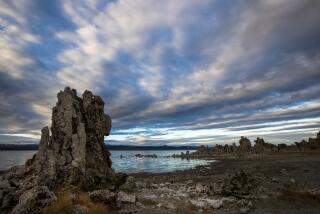Palisades Residents Say Plan to Cover Reservoir Looks Bad on Surface
A city plan for a synthetic-rubber cover over the 9.2-acre Santa Ynez Reservoir in Palisades Highlands would result in cleaner water but would create what residents describe as a âbig black holeâ in their hillside community.
The Los Angeles Department of Water and Power wants to install the cover to meet California Department of Health Services requirements for better water quality in the stateâs water districts. The cover would keep out leaves, branches and bird droppings and would prevent unhealthful algae by blocking out sunlight, said Steven L. Gerhardt, an environmental planner for ECOS Inc., which has been hired by the DWP to complete an environmental impact report on the cover.
âI can see now itâs going to be like a dirty pool cover with water gathering on top and leaves and everything else,â Stephen A. Bost, president of the Highlands Recreation Assn., said during a meeting Monday. âYou know it, I know it. Itâs going to look like hell, and itâs probably going to look like that most of the time.â
The floating black cover would be made of thin synthetic rubber called Hypalon, which is manufactured by Dupont. It would be attached to the reservoirâs perimeter and would have enough slack to rise and fall with the water level.
$3 Million Cost
Pumps would be installed to remove rain water that collects on the surface.
Thomas M. Erb, a water district environmental affairs coordinator, said the project will cost $3 million.
Before construction can begin, a final environmental impact report must be approved by the Los Angeles Board of Water and Power Commissioners, Gerhardt said. If approved, the cover will be in place after an 18-month engineering and design phase and six months of construction, he said.
The 17-year-old reservoir, on Palisades Drive in the tiny Palisades Highlands community near the ocean, north of Sunset Boulevard, holds 117 million gallons of water and serves 50,000 customers in the Pacific Palisades area. It gets its water from the Los Angeles Aqueduct Filtration Plant in San Fernando, where water from the eastern Sierra Nevada Mountains is channeled to 108 reservoirs and tanks throughout the city.
Water district officials said the cover may be ugly, but it is needed to keep the water clean.
âThereâs no doubt about it,â Gerhardt said. âIt is not as attractive as open water and no one is trying to suggest that it might be. Something needs to be done with the reservoir over the next few years to meet the water quality requirements of the state.â
Gerhardt agreed to hold a second public meeting on the project after the handful of residents who attended Monday nightâs meeting complained that notices announcing the gathering had been sent out too late for most residents to attend.
Environmental Report
Gerhardt said another notice will be sent soon to announce a second meeting in middle or late April.
The meetings are being held to gather residentsâ opinions, which will be included in a draft environmental impact report to be completed in the next several months, Gerhardt said. The draft report must be approved by the state Department of Water Resources and the Department of Health Services before it is presented to the city Board of Water and Power Commissioners for final approval.
âI donât know what the immediacy and the sudden urgency is to all this, especially in view of the fact that the letter (announcing Mondayâs meeting) is dated Feb. 23,â Bost said. âI mean, nothing works that quickly.â
Hyman H. Haves, chairman of the Palisades Highlands Home Owners Assns. said he doubts that the cover is necessary.
âWeâve lived here 10 years, and I donât know of anybody getting sick up here in 10 years from drinking this water,â he said. âIâm just amazed that suddenly out of the blue weâre in this environmental impact kick, and weâre not sure that this is going to work.â
Erb said the cover will help reduce carcinogenic trihalomethanes, produced when naturally occurring organic substances such as leaves and algae react with chlorine used to kill bacteria in water. With fewer leaves and algae in the water, less chlorine will be needed to kill the bacteria that accompany organic substances, Erb said.
Erb said the districtâs water is well within the federal limit of 100 parts trihalomethane per billion parts water, but he added that the department must anticipate stricter limits in the near future.
Filtration Systems
Eight of the DWPâs 23 reservoirs have been covered in the last 12 years, according to Erb. Five reservoirs are too big for the covers and must rely on more expensive filtration systems instead, he said.
Other local reservoirs that recently have been covered include the Palos Verdes Reservoir in Rolling Hills Estates and the Garvey Reservoir in Monterey Park, Gerhardt said. According to a Dupont brochure, 190 reservoirs nationwide have been covered with Hypalon since 1972.
Los Angeles Fire Department Battalion Chief Dean Cathey said helicopter brush-fire operations will not be affected by the cover, because water is drawn from hydrants on the reservoirâs edge, not directly from the water surface.
âWe do not obtain water in a scoop-and-run fashion as probably some of the homeowners might think,â Cathey said in a telephone interview.
Bost said officials should consider alternatives to the cover, such as the filtration systems that are installed at bigger reservoirs.
âI want nice drinking water . . .,â Bost said. âOn the other hand, I care what Iâm looking at. Looking across a beautiful canyon, youâre going to see a black hole when you buy a house with a view. I didnât buy my house for the DWP to come in and reduce its value.â
More to Read
Sign up for Essential California
The most important California stories and recommendations in your inbox every morning.
You may occasionally receive promotional content from the Los Angeles Times.










